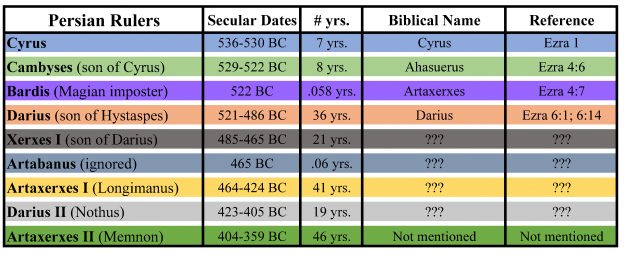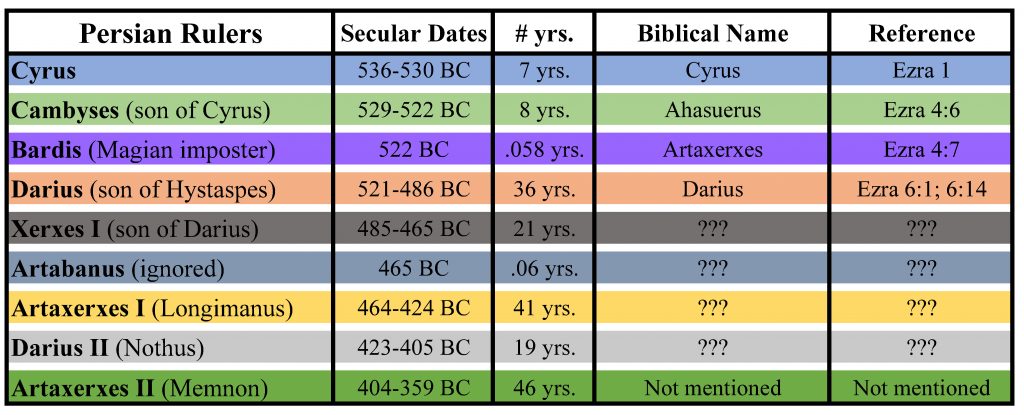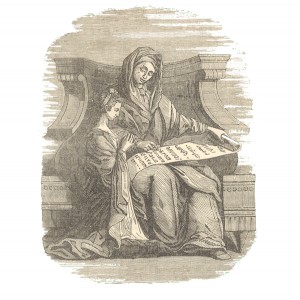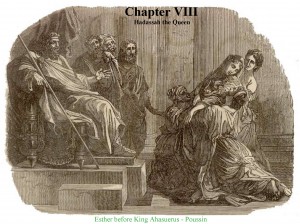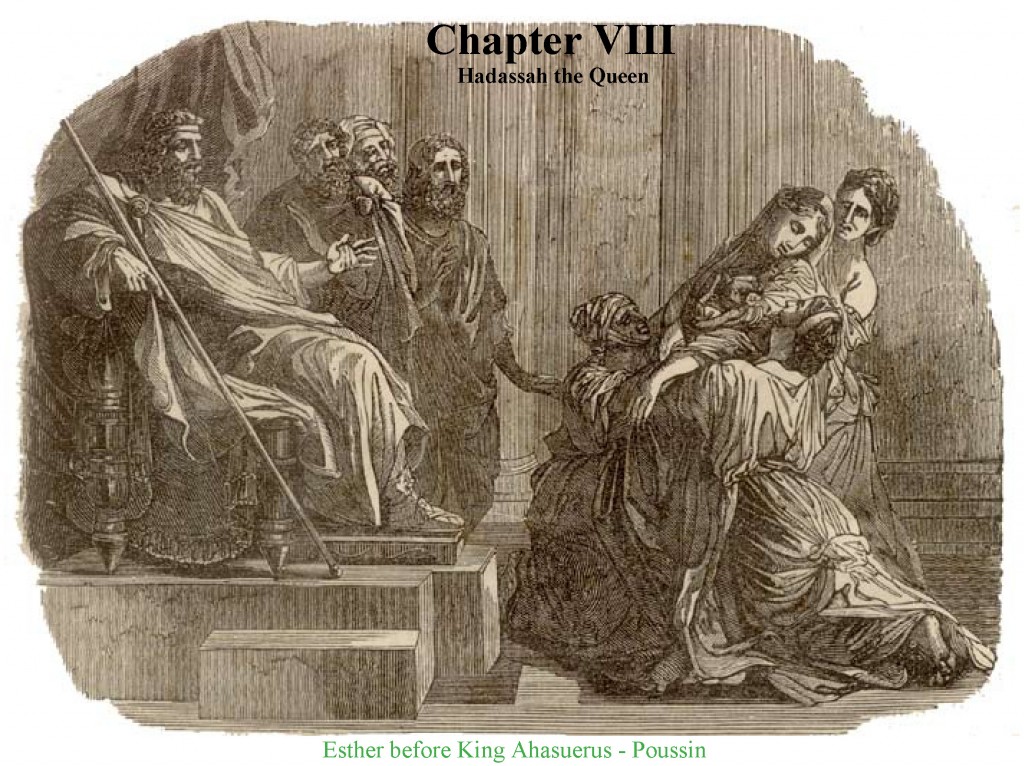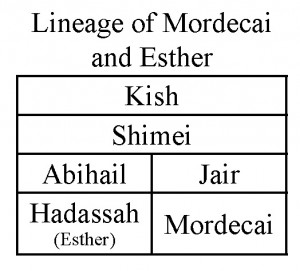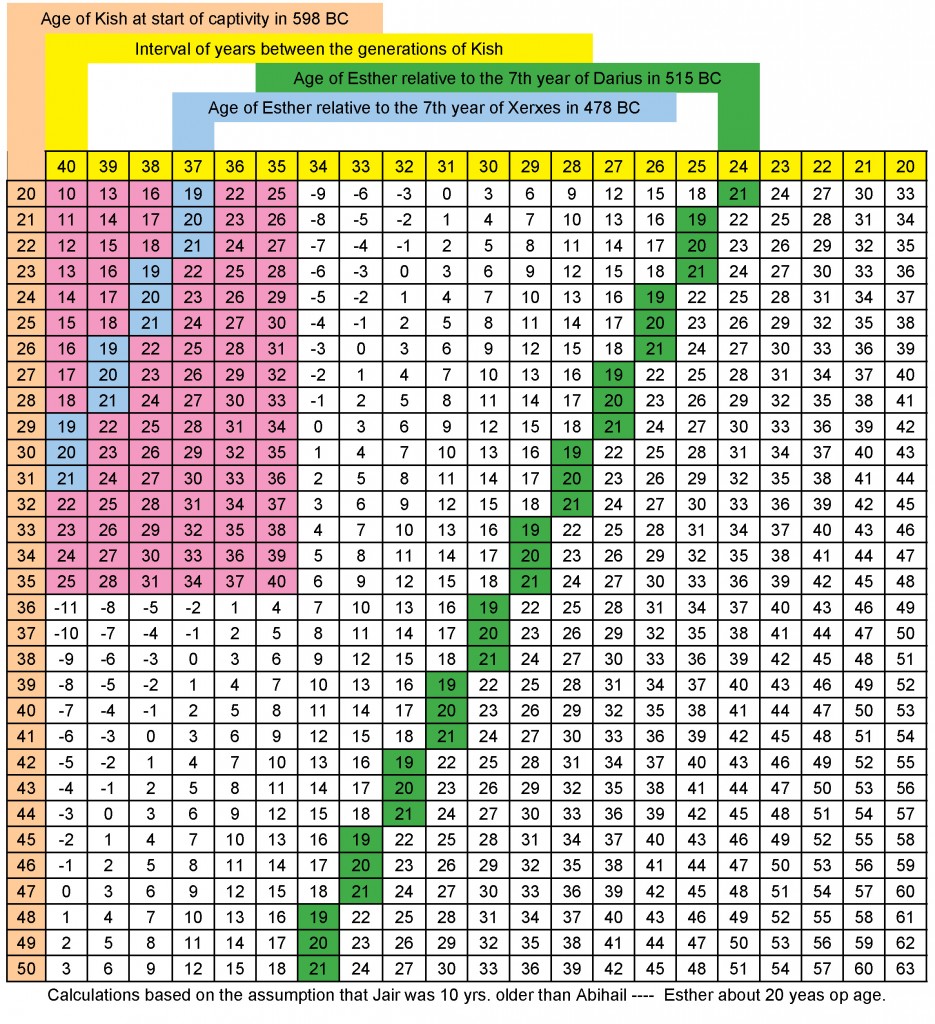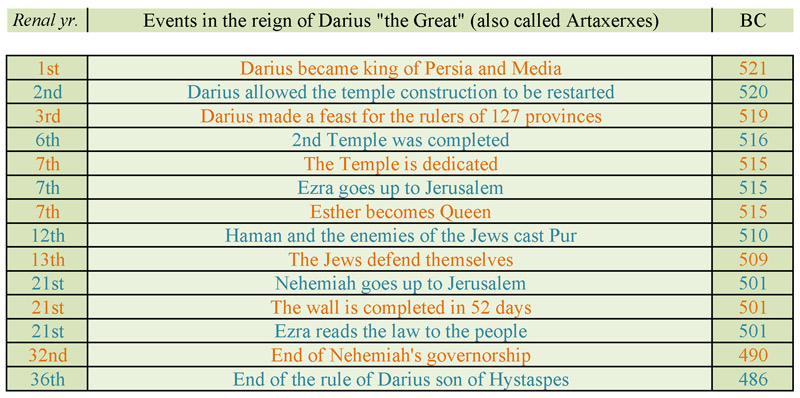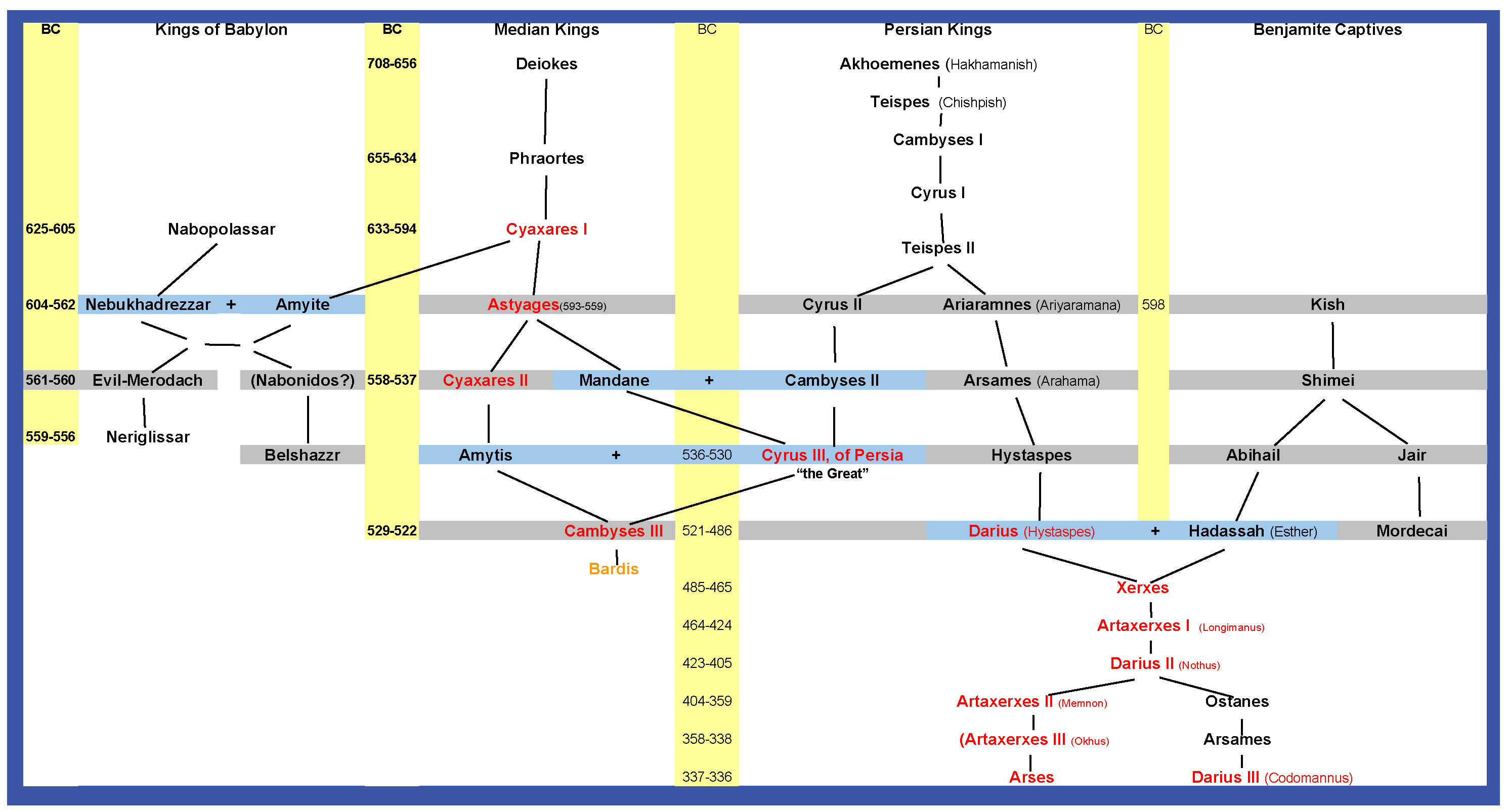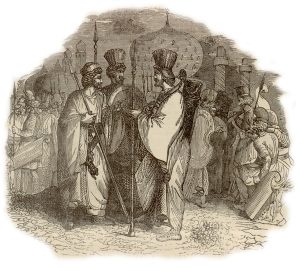 Authors Note:
Authors Note:
This is a multipart series answering the criticisms and challenges posed by Rick Lanser’s article The Seraiah Assumption as published on the Associates for Biblical Research website here: The Seraiah Assumption .
Mr. Lanser’s article directly challenges my assertion that Ezra and Nehemiah were contemporaries of the Persian king Darius also known as ‘the great’ Artaxerxes.
Articles related to this series:
The Seraiah Assumption by Rick Lanser of Associates for Biblical Research
The Seraiah Assumption: Wrapping up Loose Ends by Rick Lanser
My response to Rick Lanser’s – The Seraiah Assumption:
Introduction – The Associates for Biblical Research Responds to the Artaxerxes Assumption
Part I – Cyrus to Darius: The 2nd Temple Context of Ezra 4
Part II – Darius & Artaxerxes: The Context of the Word to Restore & Build Jerusalem
Part III – Darius the great Persian Artaxerxes: A Contextual Look at the Book of Ezra in the Light of Persian History
Part IV – Darius and the Kingdom of Arta
Part V – Darius, Artaxerxes, & the Bible: Confirming Royal Persian Titulature
Part VI – Mordecai & the Chronological Context of Esther
Part VII – Esther, Ahasuerus, & Artaxerxes: Who was the Persian King of 127 Provinces?
Part VIII – Darius I: A Gentile King at the Crux of Jewish Messianic History
Part IX – The Priests & Levites of Nehemiah 10 & 12: Exploring the Papponymy Assumption
Introductory Remarks
Over the coming weeks, as I respond to Mr. Lanser’s – Seraiah Assumption, please keep in mind that this subject is the basis for the 70 “weeks” prophecy, the only prophetic utterance in the Bible which gives us a specific and chronologically verifiable date that proves Yeshua (Jesus) is the Bible’s promised Messiah. This is an incredibly important subject that we need to have clarity about. Further, Daniel 9 and the 70 “weeks” are the prophetic foundation upon which we base much of our beliefs about Yeshua’s 2nd coming, the rapture, the wrath of God, Israel’s restoration, and the coming messianic age. That’s a lot of weight resting on little understood and even less talked about bit of 2nd temple era history.
As we explore this wonderful history my understanding of the evidence will be filtered through the Golden Rule of Bible Interpretation as described by Dr. David L. Cooper. His interpretational framework is as follows:
“When the plain sense of Scripture makes common sense, seek no other sense; therefore, take every word at its primary, ordinary, usual, literal meaning unless the facts of the immediate context, studied in the light of related passages and axiomatic and fundamental truths, indicate clearly otherwise.”
I want to make clear here, that I will first seek a “plain sense” interpretation, that a layman like myself would be able to understand and comprehend. This approach will see every word in a passage in its most primary, ordinary, usual, and literal meaning – unless – the immediate context, studied in the light of related passages and axiomatic and fundamental truths – clearly indicate otherwise. I want to emphasis this, I will only look for an alternative meaning to “plain sense” reading of the text when the passage in question is contradicted by – clear and contextual – evidence found elsewhere in the Bible.
If any of us are to solve the challenges posed by Mr. Lanser’s article The Seraiah Assumption we must have a clear and contextual understanding of the history and chronology in question. To help facilitate such a contextual understanding of the subject, this week we will explore the Persian history as described in Ezra 4-6 and I’ll offer another perspective on Mr. Lanser’s claims and in at least one instance I’ll clarify where he has mistakenly misrepresented my position.
Let’s start with a brief overview of 2nd temple era to get a solid contextual fixing point.
Cyrus Ends the 70 Years Captivity of Judah
One of the fastest ways to get off track when reading the Bible as it relates to its history is to ignore its chronological context. To clearly understand Ezra and Nehemiah’s place in Biblical history, we need to know a bit of the back story leading up to their importance in the events related to the restoration of Jerusalem and the Temple during what is commonly known as the 2nd temple era.
So with this in mind here are the Biblical passages which set the context for our understanding the book of Ezra. Please take a moment to read these important passages.
Therefore thus saith YHWH of hosts; Because ye have not heard my words, Behold, I will send and take all the families of the north, saith YHWH, and Nebuchadrezzar the king of Babylon, my servant, and will bring them against this land, and against the inhabitants thereof, and against all these nations round about, and will utterly destroy them, and make them an astonishment, and an hissing, and perpetual desolations…
And this whole land shall be a desolation, and an astonishment; and these nations shall serve the king of Babylon seventy years. And it shall come to pass, when seventy years are accomplished, that I will punish the king of Babylon, and that nation, saith YHWH, for their iniquity, and the land of the Chaldeans, and will make it perpetual desolations. And I will bring upon that land all my words which I have pronounced against it, even all that is written in this book, which Jeremiah hath prophesied against all the nations. (Jeremiah 25:8-13 – excerpted for brevity)
Now in the first year of Cyrus king of Persia, that the word [dabar] of YHWH by the mouth of Jeremiah might be fulfilled, YHWH stirred up the spirit of Cyrus king of Persia, that he made a proclamation throughout all his kingdom, and put it also in writing, saying, 2 Thus saith Cyrus king of Persia, YHWH God of heaven hath given me all the kingdoms of the earth; and he hath charged me to build him an house at Jerusalem, which is in Judah. Who is there among you of all his people? his God be with him, and let him go up to Jerusalem, which is in Judah, and build the house of YHWH God of Israel, (he is the God,) which is in Jerusalem. (Ezra 1:1-3)
That saith of Cyrus, He is my shepherd, and shall perform all my pleasure: even saying to Jerusalem, Thou shalt be built; and to the temple, Thy foundation shall be laid. (Isaiah 44:28)
Babylon 536 BC
The book of Ezra opens with the statement that the Persian king Cyrus was used by Yahweh, the living God of the Bible to punish Babylon and end the 70 years captivity of Judah. According to the text, not only did Yahweh cause Cyrus to end the 70 years captivity of Judah in Babylon, but He also compelled Cyrus to allow the repatriated captives to restore the city of Jerusalem as well as rebuild the very beating heart of that city, Yahweh’s house, the temple which had been destroyed by Nebuchadnezzar the king of Babylon. This restoration process began what is commonly known today as the 2nd temple era. The leaders of the repatriated captives were Zerubbabel (the governor) and Jeshua the high priest.
Ezra 1 and 2 informs us of the Judean captives who left Babylon and traveled to Jerusalem. Chapter 3 opens in the 7th month of the 1st year of Cyrus with the Judean captives assembling “as one man” at Jerusalem to set up an altar for sacrifices and to keep the Feast of Tabernacles. Ezra 3:8 opens in the 2nd year of the Jewish people’s return to Jerusalem with Zerubbabel the governor and Jeshua the high priest organizing the Levites into a work parties in order to restart construction of the temple. Ezra chapter 3 ends with the following description:
Now in the second year of their coming unto the house of God at Jerusalem, in the second month, began Zerubbabel the son of Shealtiel, and Jeshua the son of Jozadak, and the remnant of their brethren the priests and the Levites, and all they that were come out of the captivity unto Jerusalem; and appointed the Levites, from twenty years old and upward, to set forward the work of the house of YHWH…
And when the builders laid the foundation of the temple of YHWH, they set the priests in their apparel with trumpets, and the Levites the sons of Asaph with cymbals, to praise YHWH, after the ordinance of David king of Israel.
And they sang together by course in praising and giving thanks unto YHWH; because he is good, for his mercy endureth for ever toward Israel. And all the people shouted with a great shout, when they praised YHWH, because the foundation of the house of YHWH was laid.
But many of the priests and Levites and chief of the fathers, who were ancient men, that had seen the first house, when the foundation of this house was laid before their eyes, wept with a loud voice; and many shouted aloud for joy: So that the people could not discern the noise of the shout of joy from the noise of the weeping of the people: for the people shouted with a loud shout, and the noise was heard afar off. (Ezra 3:8-13 excerpted)
Before we move on to Ezra 4 and some of the complexities raised in Mr. Lanser’s article The Seraiah Assumption, there are a few things worth highlighting from the passages we’ve explored so far.
- Cyrus (because of Yahweh’s divine will) ended the 70 years captivity of Judah in Babylon.
- Cyrus’ “proclamation” allowed the Jewish people to restore both the city and temple of Jerusalem.
- In the 7th month of the 1st year of their return the Jewish people kept the Feast of Tabernacles
- In the 2nd month of the 2nd year of their return the priests and Levites laid the foundation of 2nd temple.
The Harassment Begins
So the Jewish people are back in their land and construction on the 2nd temple was begun by the priests and Levites. Ezra 4 tells us that it wasn’t long after construction began, that the enemies of the Jewish people began to harass them in an effort to thwart reconstruction of the Yahweh’s house. Ezra describes it this way:
Now when the adversaries of Judah and Benjamin heard that the children of the captivity builded the temple unto the LORD God of Israel; Then they came to Zerubbabel, and to the chief of the fathers, and said unto them, Let us build with you: for we seek your God, as ye do; and we do sacrifice unto him since the days of Esarhaddon king of Assur, which brought us up hither.
But Zerubbabel, and Jeshua, and the rest of the chief of the fathers of Israel, said unto them, Ye have nothing to do with us to build an house unto our God; but we ourselves together will build unto the LORD God of Israel, as king Cyrus the king of Persia hath commanded us.
Then the people of the land weakened the hands of the people of Judah, and troubled them in building, 5 And hired counsellors against them, to frustrate their purpose, all the days of Cyrus king of Persia, even until the reign of Darius king of Persia. (Ezra 4:1-5 – excerpted for brevity)
Ezra 4:1-4 tells of the initial effort of Judah’s enemies to hinder the temple construction. Verse 5 summarizes by saying these enemies hired counselors to facilitate this harassment and this harassment lasted from the reign of Cyrus until the reign of Darius the Persian. The following chart provides you with a handy reference guide for the commonly accepted succession of Persian kings and their dates and lengths of reign.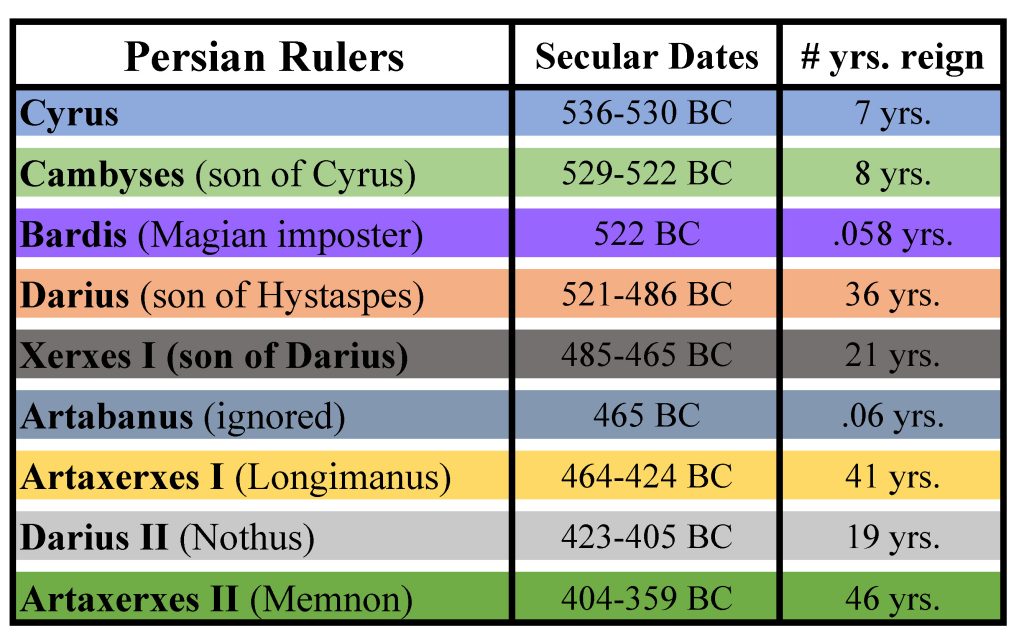
[DISPLAY_ULTIMATE_PLUS]
As you can see from this chart between Cyrus and Darius (son of Hystaspes) there are only two Persian kings noted in the historical record. This is important as we continue reading Ezra 4. Remember, my interpretive method demands that I accept it at face value in its most natural and plain sense.
So after Cyrus’ initial proclamation, Ezra 4:6 opens with the introduction of a new Persian king titled Ahasuerus during whose reign the enemies of the Jewish people continued their harassment. Now there are at least two ways to read this next passage.
- The first is to conclude that Ezra 4:5 summarized the efforts of the Jewish people’s enemies to hinder the construction between the reign of Darius and Cyrus and that verses 6-23 provide further details about that harassment that took place during those roughly 16 years.
- The 2nd way to look at this passage is to conclude that Ezra 4:6 onwards, ignores the Persian kings Cambyses and Bardis and jumps into the future describing unrelated harassment which took place after the reign of Darius sometime during the reign of a yet future Persian king who the Bible only describes as “Ahasuerus”.
And in the reign of Ahasuerus, in the beginning of his reign, wrote they unto him an accusation against the inhabitants of Judah and Jerusalem. (Ezra 4:6)
It’s worth noting here that regarding the Persian king named Ahasuerus the Bible does not indicate the efforts to hinder construction efforts were successful. But it was a different story altogether when Ezra 4:7 introduces a new Persian king named Artaxerxes. This Persian Artaxerxes king listened to the enemies of the Jewish people and after reading their letter he stopped construction of the temple.
Give ye now commandment to cause these men to cease, and that this city be not builded, until another commandment shall be given from me. Take heed now that ye fail not to do this: why should damage grow to the hurt of the kings?
Now when [‘edayin] the copy of king Artaxerxes’ letter was read before Rehum, and Shimshai the scribe, and their companions, they went up in haste to Jerusalem unto the Jews, and made them to cease by force and power. (Ezra 4:21-23)
All Construction of Jerusalem Stopped
So it seems that the enemies of the Jewish people had won. This Persian Artaxerxes ordered all construction to be stopped until he gave further notice. Ezra 4 concludes with verse 24 as follows:
Then ceased the work of the house of God which is at Jerusalem. So it ceased unto the second year of the reign of Darius king of Persia. (Ezra 4:24)
In keeping with our attempt to see this from at least two points of view Ezra 4:24 could be understood in at least two ways:
- The first and what I believe to be the most natural reading of the text is that Ezra 4 is a chronological explanation of successive events which took place during the reigns of the Persian kings Cyrus, Cambyses, Bardis, and Darius. Ezra 4:24 is the summary end cap of this successive chronological events. In other words, Cyrus gave permission for the Jewish people to rebuild the city and temple of Jerusalem. Then during the reign of Cyrus’ son Cambyses, counselors hired by the Jewish peoples enemies petitioned Cambyses to stop the temple construction. When that effort failed they tried again during the reign of the next Persian king who secular history identifies as the magian usurper Bardis. This attempt was successful and all construction stopped until the 2nd year of the reign of Darius king of Persia. (As we will subsequently learn it was during the 2nd year of Darius (son of Hystaspes) that Yahweh the living God of the Bible commanded the Jewish people to return and build the temple.)
- The second way to look at this verse is how Mr. Lanser chooses to interpret it. I’ll let him describe it in the following quotes from his article The Seraiah Assumption:
To summarize this point, to understand Ezra 4:6–23 “contextually” does not require a strictly chronological approach. The mentions of Ahasuerus and Artaxerxes are deliberate anachronisms introduced by the Spirit-inspired compiler of the records of Ezra-Nehemiah that would have been self-evident to his history-informed audience. There is no need to reinterpret the translated name of Ahasuerus or the throne name of Artaxerxes as forced references to Darius the Great. These names can be understood just as given elsewhere in Scripture, where they refer to Xerxes I and his son Artaxerxes Longimanus respectively. The plain sense is the right sense, and supports our contention that the Seraiah Assumption is the wrong way to approach the genealogy of Ezra in Ezra 7:1. (http://www.biblearchaeology.org/post/2019/04/17/The-Seraiah-Assumption-and-the-Decree-of-Daniel-925.aspx)
The Thematic Context of Ezra 4:6–23
Now we come to the conclusion of Ezra 4:24b: “…and it was stopped until the second year of the reign of Darius king of Persia.” These words are the contextual key to the chapter. They directly connect verse 24 with verse 5, “all the days of Cyrus king of Persia, even until the reign of Darius king of Persia.” The intervening verses 6 through 23 of Ezra 4 therefore constitute a parenthetical sidebar set between verses 5 and 24, continuing the theme of Samaritan-led opposition but now expressing it in their efforts to stymie the Jews in rebuilding the city instead of the Temple. The word “now” which leads off 4:6 has almost the sense of our expression “by the way…”—it introduces a jump to a tangential topic, which nevertheless has some relationship to what had already been discussed…..
In the above passage Mr. Lanser claims that Ezra 4:1-24 does not need to be read in strictly chronological manner. He suggests instead that verses 1-5 have in view the construction efforts of the Jewish people from reign of Cyrus (the Great) unto the start of the reign of Darius (son of Hystaspes) roughly 536-521 BC. Verses 6-23 he suggests are a parenthetical insertion that is not chronologically related to the verses 1-5 but describe events which transpire in the reigns of Xerxes (son of Darius) and Artaxerxes (son of Xerxes) over 40 and 60 years later respectively. After this chronological leap into the future, Mr. Lanser suggest that verse 24 jumps back from the future to the 2nd year of the reign of Darius (son of Hystaspes) in 520 BC.
This chronological incongruence Mr. Lander asserts is justified by his understanding of the use of the titles Ahasuerus and Artaxerxes elsewhere in Scripture.
If we apply Dr. Coopers approach to Ezra 4 we must first attempt to understand the passage in its most natural and plain sense given in the immediate context. Only when that fails are we justified in searching for an interpretation that goes beyond the plain sense meaning of the text.
Let me show you, why taking Ezra 4 at face value in its most natural sense as a congruent and chronological testimony of real Persian history is the best approach. In fact, as you’ll see Ezra 4 proves how important it is to stick to the Golden Rule of Bible Interpretation as the go-to-method of reading the Scripture. To demonstrate this, let’s look at Ezra 4:21-24:
21 Give ye now commandment to cause these men to cease, and that this city be not builded, until another commandment shall be given from me.
22 Take heed now that ye fail not to do this: why should damage grow to the hurt of the kings?
23 Now [‘edayin] when the copy of king Artaxerxes’ letter was read before Rehum, and Shimshai the scribe, and their companions, they went up in haste to Jerusalem unto the Jews, and made them to cease by force and power.
24 Then ceased the work of the house of God which is at Jerusalem. So it ceased unto the second year of the reign of Darius king of Persia. (Ezra 4:21-24)
To refresh the context of the above passage keep in mind that Ezra 4:7 opens with the enemies of the Jewish people writing to a Persian “Artaxerxes” in an effort to stop construction of Jerusalem. Their claim was that the Jewish people were building the city (which Cyrus’ original proclamation allowed) and if Artaxerxes didn’t put a stop to the effort it would result in hurt to the king. The king believed the council of these evil men and ordered a stop to the construction efforts. Verse 23 tells us that Artaxerxes’ letter was delivered to the Jewish people in Jerusalem and their construction efforts were stopped “by force and power”.
Carefully notice, that verse 23 opens with the Aramaic word ‘edayin which means: then, afterwards, thereupon, from that time. In this case ‘edayin’ at the opening of the sentence is used to chronologically connect verse 23 to the events which chronologically precede it. To the extent that Mr. Lanser believes the events of Ezra 4:6-23 are all chronologically related, the use of ‘edayin’ confirms it. I agree with him.
But verse 23 presents a problem for Mr. Lanser’s interpretation. The Aramaic word ‘edayin’ is used 57 times in the Old Testament. 56 of those occurrences, including the “now” of Ezra 4:23, clearly refer to successive events which take place in chronological order. In most cases the events described by the word ‘edayin’ transpire directly after previously described events of the text. The only other occurrence of the world ‘edayin’ found in the Bible is Ezra 4:24 and is represented by the English word “then”.
If we use a consistent Hermeneutics we must translate ‘edayin’ in Ezra 4:24 in the same manner we translated it in verse 23 – as well as the other 55 other occurrences of the word found in the Old Testament. There is simply no other reasonable way to see ‘edayin’ other than a chronological synchronism which connects successive events. By placing ‘edayin’ at the beginning of both verse 23 & verse 24 the author of Ezra wanted to ensure there was no confusion about the chronological order of events.
23 Now [‘edayin] when the copy of king Artaxerxes’ letter was read before Rehum, and Shimshai the scribe, and their companions, they went up in haste to Jerusalem unto the Jews, and made them to cease by force and power.
24 Then [‘edayin] ceased the work of the house of God which is at Jerusalem. So it ceased unto the second year of the reign of Darius king of Persia. (Ezra 4:22-24)
For those who would like to verify this for yourselves, here are the references for every occurrence of the word ‘edayin found in the Bible. (Ezra 4:9, 23f; 5:2, 4f, 9, 16; 6:1, 13; Dan 2:14f, 17, 19, 25, 35, 46, 48; 3:3, 13, 19, 21, 24, 26, 30; 4:7, 19; 5:3, 6, 8f, 13, 17, 24, 29; 6:3ff, 11ff, 18f, 21, 23, 25; 7:1, 11, 19)
What this contextual evidence demonstrates is that the Persian “Artaxerxes” mentioned in Ezra 4:7-23 is in fact a Persian king who ruled at some point previous to Darius (son of Hystaspes) and that by no natural reading of the text could this refer to the Persian king Artaxerxes (Longimanus). So let’s look at Ezra 4 in its natural chronological sense.
Ezra 4 opens with Jewish people beginning their construction on the temple based upon the original proclamation of Cyrus. The text then tells of efforts of their enemies to undermine those efforts. Verse 5 informs us that these enemies hired councilors to harass the Jewish people from the reign of Cyrus until the reign of Darius. Verses 6 onwards describes how these councilors petitioned a Persian king named Ahasuerus (Cambyses) to stop construction, when that did not produce results, Verses 7-23 describes how these councilors then petition a subsequent Persian king named Artaxerxes (Bardis). Their efforts to undermine the temple construction were successful with this “Artaxerxes” and in verse 24 it tells us that ‘then’ (‘edayin’) they were able to stop construction on the temple and it stopped until the 2nd year of Darius (son of Hystaspes).
23 Now [‘edayin] when the copy of king Artaxerxes’ letter was read before Rehum, and Shimshai the scribe, and their companions, they went up in haste to Jerusalem unto the Jews, and made them to cease by force and power.
24 Then [‘adayin] ceased the work of the house of God which is at Jerusalem. So it ceased unto the second year of the reign of Darius king of Persia. (Ezra 4:24)
Ironically, Mr. Lanser notices that the author of Ezra likes to give an overview of events and then fills in the details afterwards but fails to appreciate this habit as it applies to the summary of events in Ezra 4:1-5 and the subsequent details of verses 6-23. He rightly observed when quoting Brown in another place in his article:
“Having discussed the chronological anomaly above, Brown moves on to another which shows that the author of Ezra-Nehemiah displays a penchant for first telling where he is going, then explaining how he gets there.”
As you’ve seen this penchant for “first telling where he is going” that is exactly what happened in Ezra 4. The book opens with a general overview of events between Cyrus and Darius and then the author fills in the details by telling us “how he gets there”. Now take a look at our original chart which we can now update to reflect the new information we have learned by applying this plain sense reading of the text.
Misquoted and Misunderstood
Before moving on there, are a couple places where Mr. Lanser seems confused about my interpretation of Ezra 4:6-7 as it relates to Ahasuerus and Artaxerxes. He states the following in his article The Seraiah Assumption:
Just as in the case of Ahasuerus in verse 6, it is alleged that Artaxerxes in verse 7 is a title for Darius the Great. But why would the same king bear two different titles? That this is Struse’s understanding is clear from this statement in his “Queen of 127 Provinces” article: “The common thread of all the above references is that Darius ‘the Great’, also known as Artaxerxes or Ahasuerus…” (emphasis added). Why would Ezra 4:6–7 mention the same king twice, by different names, in back-to-back verses that bear every indication of talking about different people? I cannot follow this logic, and feel constrained to search for a better solution. By suggesting that both Ahasuerus and Artaxerxes are titles for Darius I, Struse has expanded the identifying terms as necessary to maintain his theory. But a theory that cannot be falsified is one that cannot be proven, either. (Lanser – http://www.biblearchaeology.org/post/2019/04/17/The-Seraiah-Assumption-and-the-Decree-of-Daniel-925.aspx)
I want to make clear here that I’ve never stated or frankly ever seriously entertained the idea that the Ahasuerus and Artaxerxes of Ezra 4:6 & 7 were references to Darius (Hystaspes) also known as ‘the great’. I’m not sure how Mr. Lanser arrived at this conclusion from reading my article Queen of 127 Provinces. I clearly did not intimate such an belief in that article. Those who would like to verify this for yourselves, can read the article here: Queen of 127 Provinces.
As we’ve learned in this article the Ahasuerus and Artaxerxes of Ezra 4, based upon the immediate context, can only be references to Cambyses and Bardis respectively. The quote provided by Mr. Lanser above is taken out of context and the chronology of Ezra 4 is not the subject under consideration. As I demonstrated in Queen of 127 Provinces, and Yahweh willing, will more fully elucidate in a subsequent article in this series, I do believe there is reasonable evidence which demonstrates that Darius (Hystaspes) was also known by the Greek titles of Ahasuerus and Artaxerxes. But to be clear – Darius is not who the Scripture has in view in Ezra 4:6 & 4:7.
Skipping the Context of the Divine Command to Restore and Build
Unfortunately for readers of Mr. Lanser’s article The Seraiah Assumption, when explaining what he terms the “Darius Assumption” he skips the context of Ezra 5 & 6 which is critical to understanding the context of Darius’ place in the 2nd temple era. This is in my opinion a great oversight which in addition to his misreading of Ezra 4 severely handicaps Mr. Lanser’s understanding of the 2nd temple era.
Yahweh willing, in my next article in this series we will look at how Yahweh’s divine command to restore and build Jerusalem, as witnessed by the two prophets Haggai and Zechariah, provides the missing context which is necessary to have an accurate understanding of the efforts of the Jewish people in rebuilding Jerusalem and the temple during the reign of Darius (the son of Hystaspes). This information will further enhance our understanding of the Persian era and provide us with further grounds upon which to establish a reasonable and accurate understanding of the 2nd temple era and Ezra and Nehemiah’s place in it.
Then the prophets, Haggai the prophet, and Zechariah the son of Iddo, prophesied unto the Jews that were in Judah and Jerusalem in the name of the God of Israel, even unto them. 2 Then rose up Zerubbabel the son of Shealtiel, and Jeshua the son of Jozadak, and began to build the house of God which is at Jerusalem: and with them were the prophets of God helping them. 3 At the same time came to them Tatnai, governor on this side the river, and Shetharboznai, and their companions, and said thus unto them, Who hath commanded you to build this house, and to make up this wall? (Ezra 5:1-3)
Key Points to Remember:
- Cyrus (because of Yahweh’s divine will) ended the 70 years captivity of Judah in Babylon.
- Cyrus’ “proclamation” allowed the Jewish people to restore both the city and temple of Jerusalem.
- In the 7th month of the 1st year of their return the Jewish people kept the Feast of Tabernacles
- In the 2nd month of the 2nd year of their return the priests and Levites laid the foundation of 2nd temple.
- The enemies of the Jewish people hired counselors to thwart their building efforts starting after the decree of Cyrus (536 BC) and continuing until the 2nd year of Darius (520 BC).
- The most natural reading of Ezra 4 shows a congruent and chronological description of events from the reign of Cyrus until the reign of Darius (Son of Hystaspes).
- This natural chronological flow of history is confirmed by the author of Ezra use of the Aramaic word ‘edayin. This word is used exclusively in the Bible to describe successive chronological information.
- This then allows us to reasonably conclude that the “Ahasuerus” of Ezra 4:6 was the Persian king Cambyses (son of Cyrus).
- This also allows us to reasonable conclude that the “Artaxerxes” of Ezra 4:7 is a reference to the Persian usurper king Bardis who was deposed by Darius (son of Hystaspes).
Articles related to this series:
The Seraiah Assumption by Rick Lanser of Associates for Biblical Research
The Seraiah Assumption: Wrapping up Loose Ends by Rick Lanser
My response to Rick Lanser’s – The Seraiah Assumption:
Introduction – The Associates for Biblical Research Responds to the Artaxerxes Assumption
Part I – Cyrus to Darius: The 2nd Temple Context of Ezra 4
Part II – Darius & Artaxerxes: The Context of the Word to Restore & Build Jerusalem
Part III – Darius the great Persian Artaxerxes: A Contextual Look at the Book of Ezra in the Light of Persian History
Part IV – Darius and the Kingdom of Arta
Part V – Darius, Artaxerxes, & the Bible: Confirming Royal Persian Titulature
Part VI – Mordecai & the Chronological Context of Esther
Part VII – Esther, Ahasuerus, & Artaxerxes: Who was the Persian King of 127 Provinces?
Part VIII – Darius I: A Gentile King at the Crux of Jewish Messianic History
Part IX – The Priests & Levites of Nehemiah 10 & 12: Exploring the Papponymy Assumption

